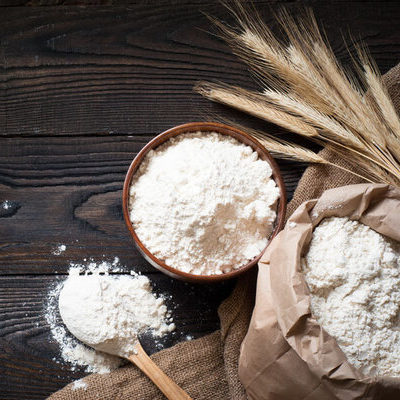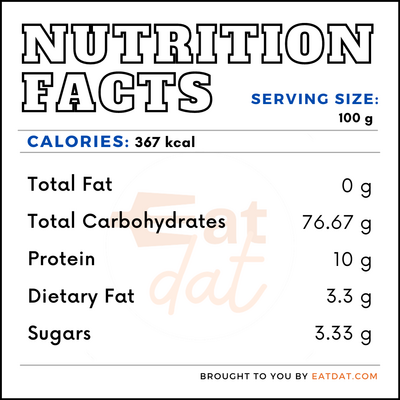
Flour
also known as All-Purpose or Plain Flour
What is Flour?
All-purpose flour is a type of highly processed white flour, most commonly used for baking, preparing desserts, and as a thickening agent for gravies.
- There are two types of wheat: hard and soft, both of which are different in protein, gluten, and starch levels.
- Of all the types of wheat products, all-purpose and whole wheat are the most popular.
Containing a mixture of both hard and soft wheat, all-purpose is deprived of the bran and the germ, or the outer coverings of the wheat grain, unlike whole-wheat. China tops wheat consumption worldwide, followed by European Union countries, India, Russia, and the USA.
Some of the most popular brands are:
- Arrowhead Mills
- Hodgson Mill
- Gold Medal
- White Lily
- Bob’s Red Mill
- Heckers
- King Arthur
- Pillsbury
Origin
Humans started making this from grains around 30,000 years ago, according to current archeological evidence. This food was made using a stone mortar and pestle. Other technical advances were gradually made over time, including watermills and windmills, that would improve the process for producing this food. The Industrial Age saw the introduction of steam mills, which began to mass-produce this, making it more accessible. Since refined white all-purpose flour had a longer shelf-life, it quickly became the more popular option.
Nutrition
All-purpose comes fortified with vitamins and minerals such as iron, riboflavin, folic acid, niacin, and B vitamins. A 100 g of flour can contain:

This also contains simple carbohydrates, due to the stripping of the outer layers which breaks down the carbohydrates, and has a high glycemic index. Refined grain intake is connected to an increased risk of cardiovascular disease, type 2 diabetes, and obesity.
Commercial production
Commercially produced all-purpose flour uses either hard wheat or a mixture of hard and soft wheat, usually in the 80:20 ratio. First, the wheat grains are milled to remove the bran and the germ, leaving the endosperm to be ground. Then, this may be bleached using bleaching agents or it may be left unbleached. Finally, it is fortified with vitamins and minerals before being packaged.
It is best stored in a cool and dark place in an airtight container. For best results, you can store this in the freezer, where it can last for up to two years. Storing it in the freezer also destroys any possibility of bugs infesting this. A good tip is to buy fresh flour when a recipe only requires it in smaller quantities.
Flour recipes
This is used in many different cuisines around the world, especially for baking. Here are a few recipes to try:
- Tortillas
- White Bread
- Hot Milk Cake
- Sugar Cookies
- Honey Beer Bread
- Maida Poori
- Scallion Pancakes
- Mandazi
- Vetkoek Bread
- Naan
- Frybread
- Fresh Pasta
FDA regulations
The FDA defines flour as food prepared by grinding and bolting any cleaned wheat, except durum and red durum wheat. This must pass a granulation test and must be free of bran coat and germ. It must also not have a moisture content of more than 15 percent. In order to prepare bleached flour, nitrogen oxide, chlorine, nitrosyl chloride, or chlorine dioxide may be used.
References
“Everything You Need to Know About Flour, From All-Purpose to Whole-Wheat.” Marthastewart.com, Martha Stewart, 26 Oct. 2017, www.marthastewart.com/1522075/flour-definitive-guide.
“Global Wheat Flour Markets, 2011-2018 & 2019-2024.” Prnewswire.com, Cision PR Newswire, 15 July 2019, www.prnewswire.com/news-releases/global-wheat-flour-markets-2011-2018–2019-2024-300884726.html.
Shahbandeh, M. “Total Wheat Consumption by Country Worldwide 2018/2019.” Statista.com, Statista, 5 Feb. 2020, www.statista.com/statistics/1094065/total-global-wheat-consumption-by-country/.
All-Purpose Flour, Bakerpedia, https://bakerpedia.com/ingredients/all-purpose-flour/
Gaesser, Glenn A. “Perspective: Refined Grains and Health: Genuine Risk, or Guilt by Association?.” Advances in nutrition (Bethesda, Md.) vol. 10,3 (2019): 361-371. doi:10.1093/advances/nmy104, https://www.ncbi.nlm.nih.gov/pmc/articles/PMC6520038/
